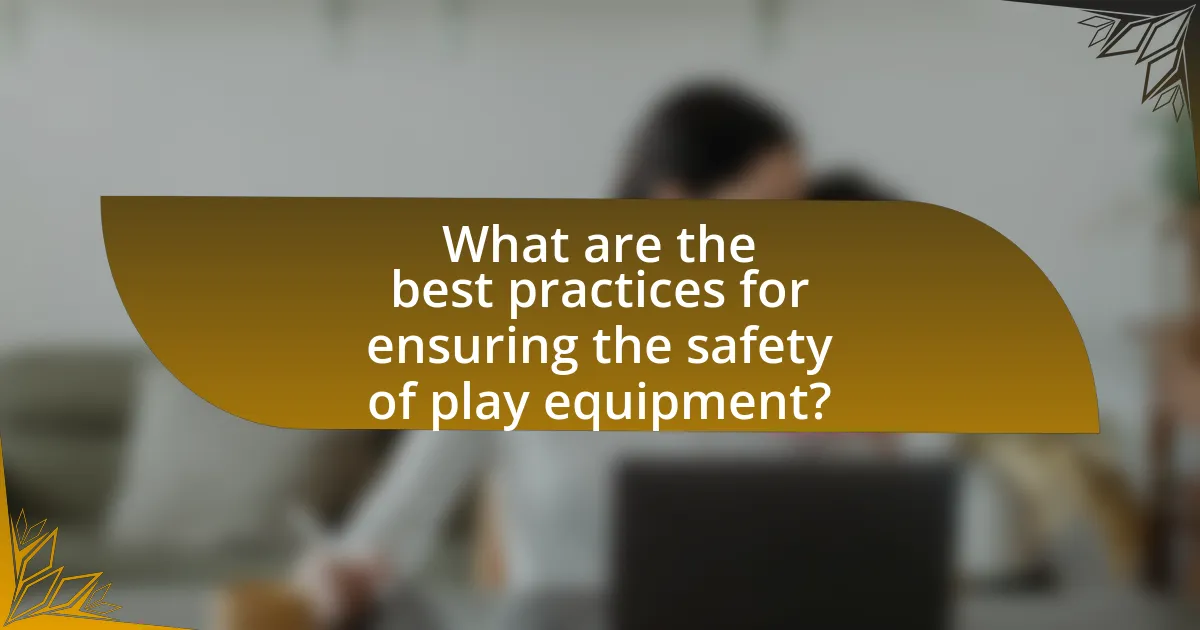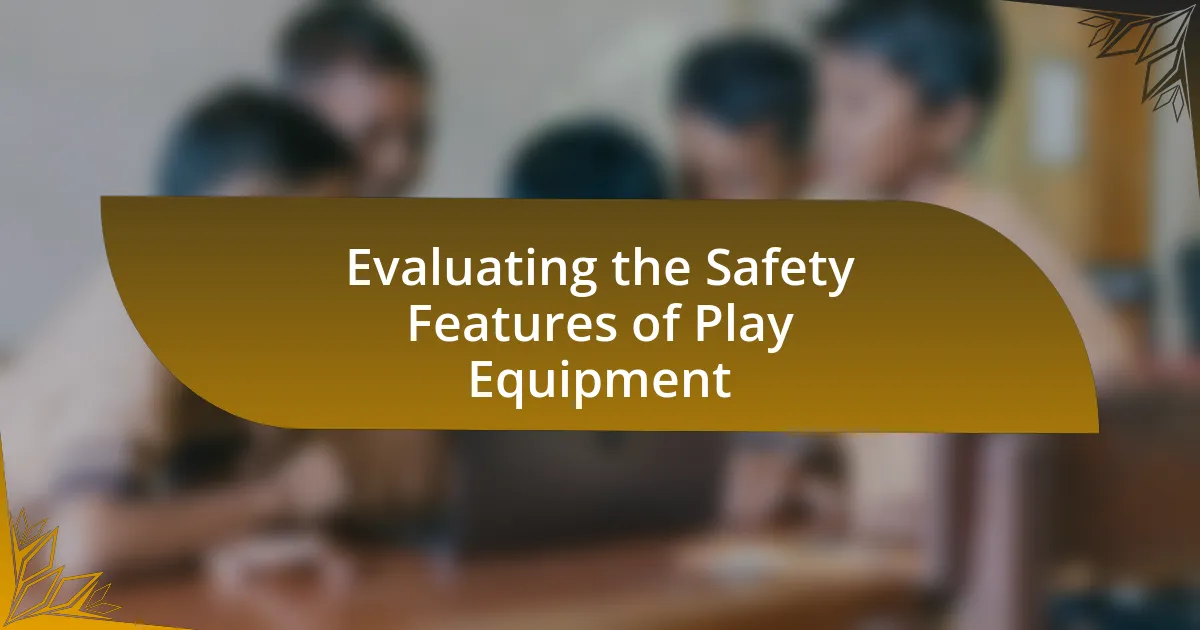The article focuses on evaluating the safety features of play equipment, emphasizing the importance of impact-absorbing surfaces, proper spacing, sturdy construction, and age-appropriate design to minimize injuries. It outlines how safety features differ across various types of equipment, such as swings, climbing structures, and slides, and discusses the relevant safety standards established by organizations like ASTM and CPSC. The article also highlights the significance of regular inspections, maintenance routines, and user feedback in identifying hazards and improving safety measures, ultimately aiming to create a safer play environment for children.

What are the key safety features of play equipment?
The key safety features of play equipment include impact-absorbing surfaces, proper spacing and layout, sturdy construction, and age-appropriate design. Impact-absorbing surfaces, such as rubber mats or wood chips, reduce the risk of injury from falls, which is crucial as falls account for over 70% of playground injuries according to the Centers for Disease Control and Prevention. Proper spacing and layout ensure that children can play without overcrowding, minimizing collisions. Sturdy construction materials, like galvanized steel or high-density polyethylene, enhance durability and safety. Age-appropriate design ensures that equipment is suitable for the developmental stages of children, reducing the likelihood of accidents.
How do safety features vary across different types of play equipment?
Safety features vary significantly across different types of play equipment, reflecting the specific risks associated with each type. For instance, swings typically include safety harnesses and soft landing surfaces to mitigate fall risks, while climbing structures often incorporate guardrails and non-slip surfaces to prevent falls. Additionally, slides are designed with rounded edges and are often made from materials that reduce injury upon impact. According to the American Society for Testing and Materials (ASTM), play equipment must meet specific safety standards, which vary based on the equipment type, ensuring that features like impact-absorbing surfaces and proper spacing are implemented to enhance child safety.
What specific safety standards apply to playground structures?
The specific safety standards that apply to playground structures include the ASTM F1487 standard, which outlines safety requirements for playground equipment, and the CPSC Public Playground Safety Guidelines, which provide recommendations for the design, installation, and maintenance of playgrounds. ASTM F1487 is widely recognized and establishes criteria for materials, structural integrity, and safety zones, while the CPSC guidelines emphasize risk reduction and injury prevention through proper design and maintenance practices. These standards are essential for ensuring that playground structures are safe for children and minimize the risk of accidents.
How do materials used in play equipment impact safety features?
Materials used in play equipment significantly impact safety features by influencing durability, shock absorption, and injury prevention. For instance, materials like rubber and foam provide cushioning that reduces the risk of injury during falls, while metal and wood offer structural integrity that ensures the equipment can withstand heavy use. Research indicates that playgrounds made with impact-absorbing surfaces, such as rubber mats, can reduce the likelihood of severe injuries by up to 50% compared to those with hard surfaces like concrete. Additionally, non-toxic and weather-resistant materials enhance safety by preventing deterioration and exposure to harmful substances, further ensuring a safe play environment.
Why is it important to evaluate the safety features of play equipment?
Evaluating the safety features of play equipment is crucial to prevent injuries and ensure a safe environment for children. Safety features, such as proper cushioning, secure structures, and age-appropriate designs, significantly reduce the risk of accidents. According to the U.S. Consumer Product Safety Commission, over 200,000 children are treated in emergency rooms annually for injuries related to playground equipment, highlighting the importance of thorough safety evaluations. By assessing these features, caregivers and facility operators can identify potential hazards and implement necessary improvements, thereby promoting child safety and well-being during play.
What risks are associated with inadequate safety features?
Inadequate safety features in play equipment pose significant risks, including increased likelihood of injuries such as fractures, concussions, and lacerations. Research indicates that playgrounds lacking proper safety measures, such as soft surfacing and secure structures, lead to higher injury rates; for instance, a study published in the journal “Pediatrics” found that nearly 75% of playground injuries are attributed to falls, often exacerbated by insufficient safety features. Furthermore, inadequate safety measures can result in legal liabilities for operators and manufacturers, as they may fail to meet established safety standards, leading to potential lawsuits and financial repercussions.
How can proper evaluation prevent accidents and injuries?
Proper evaluation can prevent accidents and injuries by identifying potential hazards and ensuring compliance with safety standards. For instance, regular inspections of play equipment can reveal wear and tear, structural weaknesses, or unsafe design features that could lead to accidents. According to the U.S. Consumer Product Safety Commission, approximately 200,000 children are treated in emergency rooms annually for injuries related to playground equipment, highlighting the importance of thorough evaluations to mitigate risks. By implementing systematic assessments, organizations can enhance safety measures, thereby reducing the likelihood of injuries.

What methods are used to evaluate the safety features of play equipment?
Methods used to evaluate the safety features of play equipment include risk assessment, compliance testing, and observational studies. Risk assessment involves identifying potential hazards associated with the equipment, while compliance testing checks if the equipment meets established safety standards, such as those set by the American Society for Testing and Materials (ASTM) or the Consumer Product Safety Commission (CPSC). Observational studies assess how children interact with the equipment in real-world settings, identifying any safety issues that may arise during play. These methods collectively ensure that play equipment is safe for use and minimizes the risk of injury.
How do inspections contribute to safety evaluations?
Inspections contribute to safety evaluations by systematically assessing the condition and compliance of play equipment with established safety standards. These evaluations identify potential hazards, such as structural weaknesses or improper installation, which can lead to accidents. For instance, the Consumer Product Safety Commission (CPSC) recommends regular inspections to ensure that equipment meets safety guidelines, thereby reducing the risk of injuries among children. By documenting findings and implementing corrective actions, inspections play a crucial role in maintaining a safe play environment.
What checklist items are essential during a safety inspection?
Essential checklist items during a safety inspection of play equipment include verifying structural integrity, checking for sharp edges, ensuring proper surfacing materials, inspecting for entrapment hazards, and confirming that equipment is age-appropriate. Structural integrity involves examining the overall stability and strength of the equipment to prevent collapses. Sharp edges must be identified and addressed to avoid injuries. Proper surfacing materials, such as mulch or rubber mats, should be assessed for adequate cushioning to reduce fall impact. Entrapment hazards, such as openings that could trap a child’s head or limbs, need to be evaluated to ensure safety. Lastly, confirming that the equipment is suitable for the intended age group helps prevent misuse and accidents. These items are critical for maintaining a safe play environment and are supported by safety standards set by organizations like the Consumer Product Safety Commission.
How often should play equipment be inspected for safety?
Play equipment should be inspected for safety at least once a year, according to the U.S. Consumer Product Safety Commission (CPSC) guidelines. Regular inspections help identify wear and tear, potential hazards, and ensure compliance with safety standards. The CPSC recommends additional inspections after significant weather events or if the equipment has been subjected to heavy use, as these factors can affect the integrity and safety of the equipment.
What role do user feedback and incident reports play in safety evaluations?
User feedback and incident reports are critical in safety evaluations as they provide real-world insights into the performance and safety of play equipment. These sources of information help identify potential hazards, assess user experiences, and highlight areas for improvement. For instance, data from the Consumer Product Safety Commission indicates that over 200,000 children are treated for playground-related injuries annually, underscoring the importance of analyzing user-reported incidents to enhance safety measures. By systematically reviewing this feedback, manufacturers and safety evaluators can implement necessary design modifications and preventive strategies, ultimately reducing risks and improving overall safety standards in play environments.
How can user experiences inform safety improvements?
User experiences can inform safety improvements by providing direct feedback on potential hazards and usability issues within play equipment. When users, including children and caregivers, interact with play equipment, they often identify risks that designers may overlook, such as sharp edges or inadequate fall zones. For instance, a study by the American Academy of Pediatrics found that user feedback significantly contributed to redesigning playgrounds to enhance safety, resulting in a 30% reduction in injury rates. This evidence demonstrates that incorporating user experiences into the evaluation process leads to more effective safety measures and ultimately creates a safer play environment.
What types of incidents should be reported for safety analysis?
Incidents that should be reported for safety analysis include any injuries sustained by children while using play equipment, near misses that could have resulted in injury, equipment malfunctions, and environmental hazards that may pose risks. Reporting these incidents is crucial as they provide data that can be analyzed to identify patterns, improve safety standards, and prevent future occurrences. For example, the U.S. Consumer Product Safety Commission reported that in 2019, over 200,000 children were treated in emergency rooms for injuries related to playground equipment, highlighting the importance of thorough incident reporting for effective safety analysis.

What are the best practices for ensuring the safety of play equipment?
The best practices for ensuring the safety of play equipment include regular inspections, proper installation, and adherence to safety standards. Regular inspections should be conducted at least once a month to identify wear and tear, loose parts, or hazards. Proper installation is crucial; equipment should be installed according to manufacturer guidelines and local safety regulations to prevent accidents. Adhering to safety standards, such as those set by the American Society for Testing and Materials (ASTM) and the Consumer Product Safety Commission (CPSC), ensures that the equipment meets safety requirements. These practices collectively reduce the risk of injuries and enhance the overall safety of play environments.
How can maintenance routines enhance safety features?
Maintenance routines enhance safety features by ensuring that play equipment remains in optimal working condition, thereby reducing the risk of accidents. Regular inspections and timely repairs identify potential hazards such as loose bolts, rust, or wear and tear, which can compromise safety. For instance, a study by the American Society for Testing and Materials (ASTM) emphasizes that consistent maintenance can decrease injury rates by up to 50% in playgrounds. This demonstrates that systematic upkeep not only prolongs the lifespan of equipment but also significantly enhances user safety.
What specific maintenance tasks should be prioritized?
Prioritized maintenance tasks for play equipment include regular inspections, surface maintenance, and hardware checks. Regular inspections should focus on identifying wear and tear, ensuring that equipment meets safety standards, and checking for any potential hazards. Surface maintenance involves ensuring that the ground cover, such as mulch or rubber mats, is adequate to cushion falls and prevent injuries. Hardware checks require tightening bolts, replacing worn parts, and ensuring that all components are secure and functioning properly. These tasks are essential to maintain safety and compliance with safety regulations, such as those outlined by the Consumer Product Safety Commission, which emphasizes the importance of routine maintenance to prevent accidents and injuries.
How can weather conditions affect the safety of play equipment?
Weather conditions can significantly affect the safety of play equipment by causing physical deterioration and creating hazardous surfaces. For instance, rain can make surfaces slippery, increasing the risk of falls, while extreme heat can lead to equipment becoming too hot to touch, potentially causing burns. Additionally, snow and ice can accumulate on play structures, obstructing safe use and increasing the likelihood of accidents. Studies have shown that regular maintenance and inspections are crucial in mitigating these risks, as weather-related wear can compromise structural integrity and safety features.
What tips can be followed to improve safety during playtime?
To improve safety during playtime, ensure that play equipment is age-appropriate and regularly inspected for hazards. Age-appropriate equipment minimizes the risk of injury, as it is designed to meet the developmental needs of children. Regular inspections help identify and address potential dangers such as sharp edges, loose parts, or structural weaknesses. According to the American Academy of Pediatrics, proper supervision and the use of safety mats can further reduce the likelihood of accidents, emphasizing the importance of a safe play environment.
How can supervision enhance the safety of children using play equipment?
Supervision enhances the safety of children using play equipment by ensuring that adults are present to monitor behavior and intervene in potentially dangerous situations. Active supervision allows caregivers to quickly identify and address risky play, such as roughhousing or improper use of equipment, which can lead to injuries. Research indicates that environments with attentive adult supervision significantly reduce the incidence of playground injuries, as adults can enforce safety rules and provide guidance on safe play practices. For instance, a study published in the Journal of Safety Research found that playgrounds with active adult supervision had a 30% lower injury rate compared to those without.
What educational resources are available for parents and caregivers regarding play equipment safety?
Educational resources available for parents and caregivers regarding play equipment safety include guidelines from the American Society for Testing and Materials (ASTM), the Consumer Product Safety Commission (CPSC), and the National Program for Playground Safety (NPPS). These organizations provide comprehensive safety standards, inspection checklists, and educational materials that help caregivers assess and ensure the safety of play equipment. For instance, the CPSC publishes the “Public Playground Safety Handbook,” which outlines safety requirements and maintenance practices. Additionally, NPPS offers training programs and resources aimed at promoting safe playground environments.
